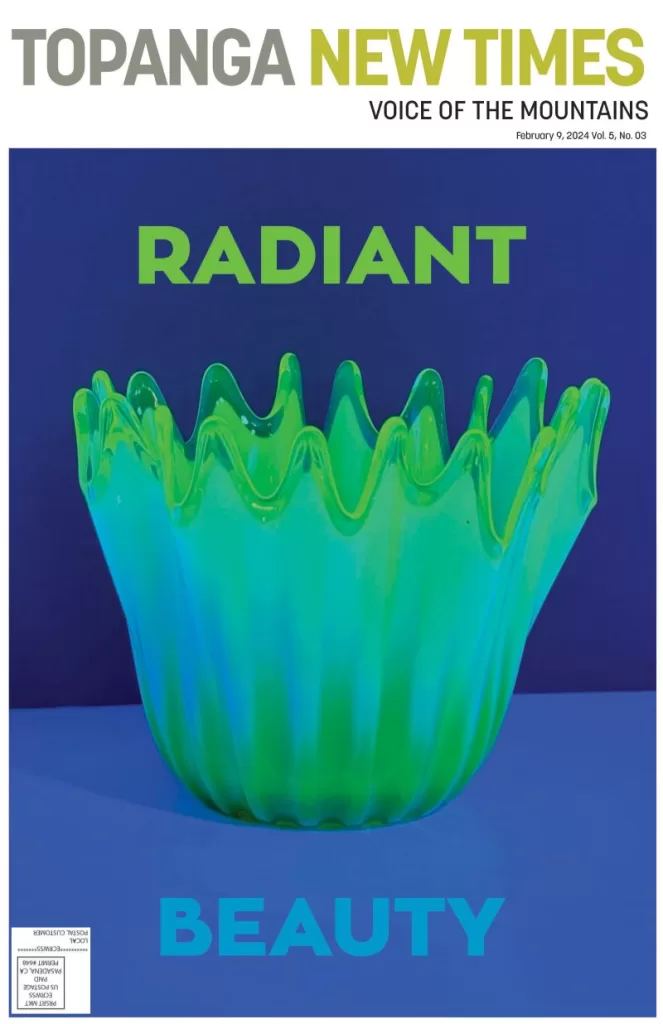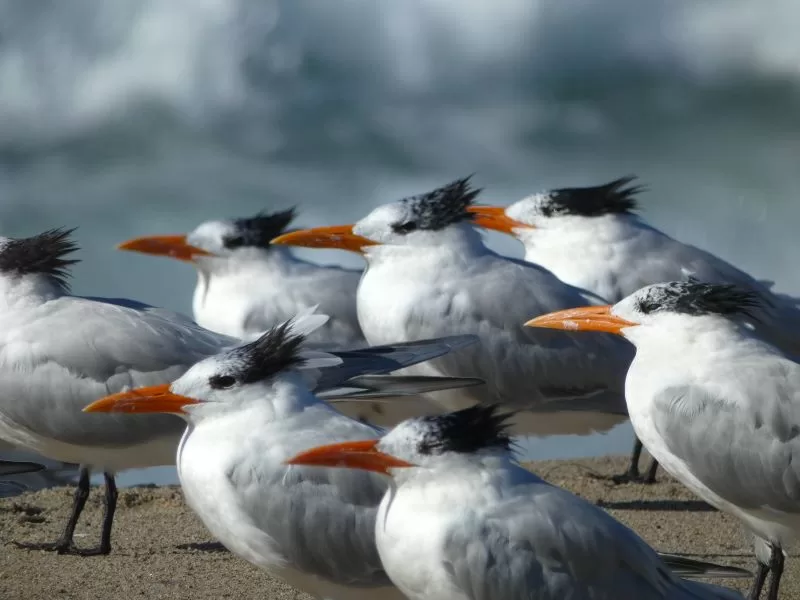
Radioactive glassware is a hot commodity—literally and figuratively. Uranium glass, colored with the radioactive element, was manufactured throughout much of the nineteenth and early twentieth century. Pieces like this hand-blown art glass vase are popular collectables today, prized for the unearthly glow they reveal under UV light, and their ability to set a geiger counter clicking. Join TNT for an illuminating look at a curious chapter in history, some red hot collectables, and a link to a local landmark. Cover concept and design by Urs Baur
More than 14 inches of rain fell on Topanga during the first week of February. It was still raining when TNT went to press. Rising water caused the creek to breach the roadway at Highvale, on Topanga Canyon Boulevard north of the elementary school, flooding and stranding at least eight vehicles. Ten people, including a baby, were rescued. T-CEP—the Topanga Coalition for Emergency Preparedness—reported that fire crews had to bulldoze their way through 200 feet of mud.
Road crews and emergency responders have been kept busy throughout the Santa Monica Mountains. A rockslide on Sadie Road off Saddle Peak Road, completely blocked access for residents. Further down the mountain, multiple vehicles were submerged by mud and flood water on Piuma Road. More vehicles were swamped on Cornell Road, near Malibou Lake. Radio station K-BU’s Hans Laetz reported that some structures at the lake may also have been flooded, and that the water lever was “up to and over” the hoods of the cars.
Six homes in the Beverly Crest neighborhood above Beverly Hills, eight in Studio City on the Valley side of the mountains, and three in Tarzana were damaged or destroyed by mudflows during this storm system. Residents of Santa Maria Road, north of Topanga Canyon, were under a mandatory evacuation order from the Los Angeles County Office of Emergency Management because of the high risk of mudflows there.
Rain isn’t the only problem. The stretch of Pacific Coast Highway at Thornhill Broome State Beach, north of Malibu, was damaged by big waves generated by the storm and powered by astronomical high tides. Two lanes have been reopened, but extensive repairs will be needed.
Damage assessment and mopping up when the rain is over will take time, but emergency funding is being made available for anyone who suffered property damage or loss. California Governor Gavin Newsom preemptively declared a state of emergency to free up funds for the cleanup effort.
Topanga hasn’t experienced flooding on this scale for a while, but it has happened many times in the past: In January of 1969, 34 inches of rain fell in the canyon, washing several houses away. Residents had to be rescued using a precarious arrangement of ropes and buckets—there was no Malibu Search and Rescue organization back then.
In 1980, catastrophic flooding generated a “wall of flood water” that washed away houses and cars. That event remains the biggest flood disaster in recent local history.
In 1995, the boulevard was closed for weeks following severe flooding and a massive rock slide. In 2019, heavy rains resulted in multiple rockslides and lengthy road closures. If climate change predictions are accurate, this cycle will intensify, and the rugged topography of the Santa Monica Mountains greatly increases the potential for flooding and rockslides. Living in the wildland interface means learning to adjust to forces far beyond our control—it’s the price for life in a place that has been described as very near terrestrial paradise.

Understanding where and why rock slides occur can help mitigate risk. TNT readers who would like to help researchers at the California Geological Survey gather data on rock and debris flows are encouraged to send reports, photographs, and locations—GPS data if possible—to [email protected]. Documenting even minor rock slide activity can help fill in missing details about the geology of the Santa Monica Mountains. This is a volunteer citizen science project. Participants need to prioritize their own safety when taking photos, but the data provided can help more accurately map slide risks in our local mountains.
Fire and flood are part of the cycle of life in the Santa Monica Mountains. During major events like the atmospheric river of rain we are experiencing this February that cycle has the potential to generate life-threatening hazards. Evacuation orders should be taken seriously. Mud can move astonishingly fast. Floodwater has terrifying strength and power, even when it looks as innocuous as chocolate milk or appears to be only a few inches deep. “Turn around; don’t drown” is good advice.
We hope all of our readers are staying safe and dry. Sandbags continue to be available at all Los Angeles County fire stations in the area. It’s a good idea to keep an eye on T-CEPS emergency status page, tcep.org/emergencystatus, and check for road closures and hazards before trying to travel through any of our canyon or coast roads during heavy rain or in its aftermath.
Stay safe, be well.













